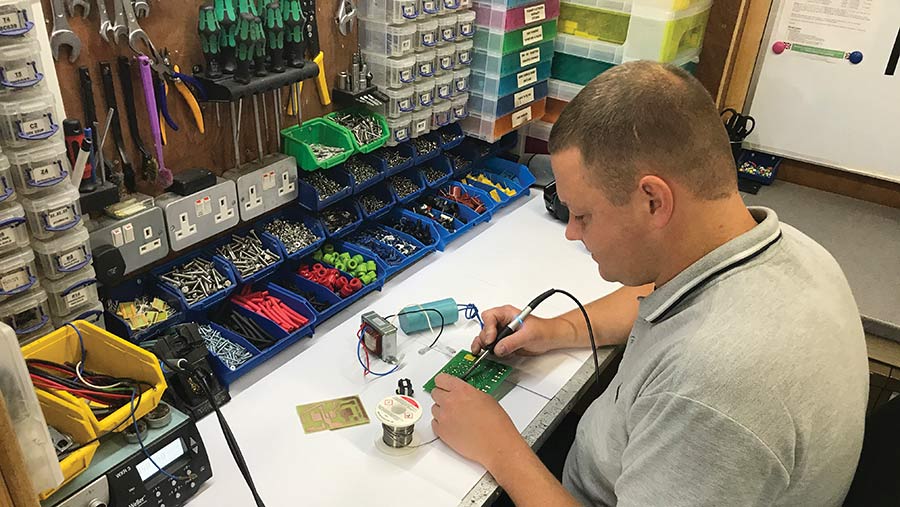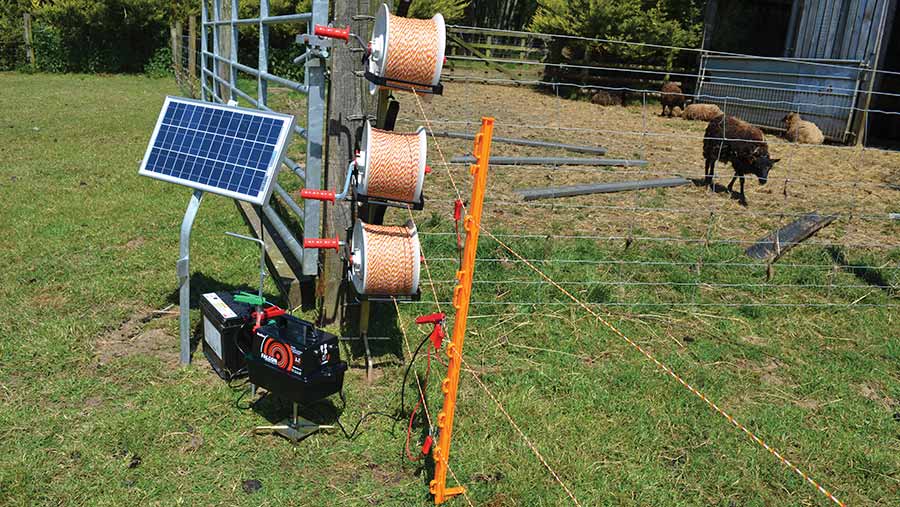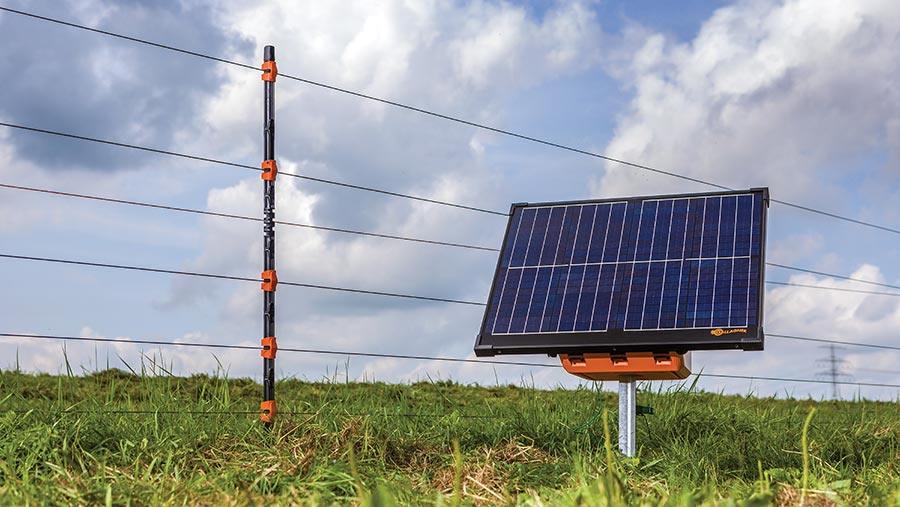How To Set Up A Solar Electric Fence
Putting an end to the monotonous charging and distribution of electric fencer batteries would exist a boon for any livestock farmer.
So, it'due south no surprise that involvement in solar-powered energisers has been gathering momentum over the past few years.
Smaller integrated units were the first to exist introduced to the marketplace, offer a low-cal, handy package that's platonic for short runs, such equally setting up a pocket-sized strip-grazing system.
See also: How to build the perfect livestock fence
Although some promise to embrace reasonable distances, information technology'due south important to note that these are a bit similar mpg figures in the car globe – they're simply achievable in the best possible atmospheric condition, when the sun is blazing, the best-quality wire and earthing are in place and there is no vegetation clogging the line.
In the real world, where the undergrowth will get unruly and ground weather condition give a less-than-perfect earth, these figures are going to be lower.
Some large all-in-i fencing units are now available, but for stock farmers in search of a year-round system that takes the force per unit area off battery charging, it oft makes more sense to purchase a solar-help console to piece of work with their existing fencing unit.
During sunny spells, these have the capacity to run some of the largest 12V energisers without drawing any power from the battery during the solar day.
Giving the cells only dark-time hours to cover means the battery will go far longer without needing a charge from the mains, which saves time and prolongs its life.
Most of the main energiser manufacturers will offer solar-assist panels to complement their units.
Just for those who want to save a few quid, it's possible to source panels and the components independently. Still, information technology's crucial to make sure the console is a suitable size for the fencing unit.
With the help of independent electric fence repair specialist Arran Lange of AL Electric Fencing, we take a look at the steps involved in getting the perfect solar-assisted setup.
Choosing an energiser
Nigh 12V battery-powered energisers are good candidates for pairing with a solar-assist panel.
Farmers who already have an energiser suitable for their requirements tin can skip direct to the department on solar panels, but the following pointers will assistance if 1 does demand to exist purchased.
Output is the first consideration, and this is measured in joules (J). Some brands will quote the unit of measurement's stored energy, which relates to the amount of energy independent within the energiser.
Nonetheless, the output effigy is more important, equally this gives an accurate indication of how much energy will laissez passer out of the unit and travel down the contend line. There isn't always that much difference between the two figures, though.
In real-world weather condition, 1km of fencing wire requires almost 0.5J of energy, so once an gauge has been made of the distance needing to be fenced, information technology'south relatively straightforward to pick a suitably sized fencer.
It is important to call back that distance ratings usually refer to a single strand of wire, so a 3-strand debate will need triple the output.
Vegetation also limits energiser performance – a bit similar holes in a hose pipage reducing the corporeality of h2o reaching the end – so in areas where this is expected to be high, it is worth investing in a larger unit or taking the time to keep the argue line clear.
Opting for a college-powered fencer has a similar consequence to opening the tap on the leaky pipe, meaning more than voltage volition achieve the end of the argue line.
How big does my fencer demand to be?
Getting the correct size of solar fencer for the amount of footing you demand to embrace is one of the most of import considerations.
It'due south also worth going slightly bigger than current requirements, so there is capacity to expand over time.
The "Fence length guide" table (below) gives a crude guide of the linear lengths of fencing required for different-sized fields, and the 2d tabular array has the fencer requirements to embrace that length.
Fence length guide | |||
| Field size | Single-strand argue | Three-strand contend | Sheep net (8-strand) |
| 1ha | 400m | 1.2km | 3.2km |
| 4ha | 800m | 2.4km | half dozen.4km |
| 9ha | ane.2km | iii.6km | nine.6km |
| 16ha | 1.6km | 4.8km | 12.8km |
| 25ha | 2km | 6km | 16km |
| 36ha | ii.4km | seven.2km | nineteen.2km |
| 81ha | three.6km | 10.8km | 28.8km |
| 196ha | 5.6km | xvi.8km | 44.8km |
| The higher up is a rough guide and the distances are based on perfect squares. Rectangular and irregularly shaped fields volition take larger perimeters than those in a higher place. | |||
Google altitude measuring
Google Maps can exist used to give a more than accurate indication of contend length. On satellite view, click on a indicate in the corner of a field and so right click and select the measure altitude function.
Selecting each corner of the field will then requite a adding of the perimeter, as well as the field size. The line can be dragged to get the right field shape. The ACME Planimeter is another nifty tool for doing this.
Energiser size guide | |||
| Energiser-stored joules | Minimal vegetation | Boilerplate vegetation | High vegetation |
| 0.five | 3km | 1.5km | 0km |
| 1.vi | 22km | iii.5km | one.3km |
| ii.0 | 25km | 4km | 1.5km |
| 3.75 | 35km | 7.5km | 4km |
| five.4 | 40km | 11km | 6km |
Output voltage is another spec worth looking upwards, as the unit needs to maintain a minimum of 3,000V at the end of the fence line to incorporate livestock. This is especially of import for sheep, as they are well insulated.
As a rough guide, a decent-quality 1.7-2J 12V energiser can be picked upwards for less than £200.
Solar panel pitfalls
There are plenty of inexpensive solar panels available online, but a degree of research is needed before buying 1 and hooking it up to a battery powering an energiser.
Buying a panel that's besides pocket-sized results in little extension to the battery life, while choosing one that is too big can risk dissentious both the battery and the energiser, unless the output is regulated.
The simplest manner to get a suitable panel is to source i through the energiser manufacturer, as information technology will ensure the units are compatible. Merely those who want to shop around for a decent deal will need to follow a few golden rules.
Firstly, the wattage of the panel should complement the wattage of the energiser. For example, a Hotline Falcon (a popular unit in the UK) operates at about 30W, and so on a bright twenty-four hour period, a 30W solar panel should keep the batteries topped upward.
Nonetheless, the reduction in power output from the panel during the night and on dull days means the batteries volition eventually need charging from the mains.
Upping the panel size to 50W can help offset that divergence and, when teamed with a decent battery, this setup could probably cope with yr-round operation in UK conditions without any boosted charging.
Secondly, it's important to notation that larger solar panels can put out more than 20V when they are working at total capacity.
The ideal voltage for 12V bombardment charging is only over 14V, and then continually bombarding it with loftier voltage on a sunny day won't practice the battery or energiser much good.
The answer is to fit a charge controller. These are elementary to wire in between the panel and battery, and ensure the voltage stays at a condom level.
Once the system is prepare, it's sensible to use a multimeter to make sure the output voltage is correct. The console should point due south and exist free from shade to piece of work to its full potential.
When shopping for a solar panel, buyers will generally come across two different types. Monocrystalline is the more expensive option and these have solar cells made from a single crystal of silicon, which is said to make them more efficient.
Polycrystalline, meanwhile, are fabricated from many fragments of silicon that are melted together. The easy way to tell them apart is that monocrystalline panels are black and polycrystalline have a blueish hue.
Prices for solar panels vary considerably but, as a general dominion, a decent 50W monocrystalline unit of measurement can be sourced for £150 or less and charge controllers tin can be picked upwards for under £fifty. Expect to pay a bit more for panel setups from energiser manufacturers.
Batteries
Although enough of people run fencers off old tractor and car batteries, they're not ideal for the job.
This is because they are not designed for repeated discharging and charging cycles, and the thin plates eventually surrender the ghost.
However, using a solar panel with this type of bombardment can significantly extend its lifespan, as it is getting regular superlative-ups, rather than running total to apartment all the time.
A deep-cycle leisure battery is the preferred power source, and 70 ampere hour (Ah), 80Ah or 110Ah units are the best choices for larger fencers.
The bigger the amp hour, the longer the run time, so teaming a large fencer with a 110Ah battery and 50W panel will get close to achieving charge-free running.
Quality 110Ah leisure batteries cost virtually £100.
Repairing one-time energisers
Arran Lange of AL Electric Fencing has been fixing electric debate energisers at his workshop in Chesterfield, Derbyshire, for nigh a decade, and has experience of all brands commonly institute in the United kingdom of great britain and northern ireland.

Arran Lange
He finds older units are the simplest to repair, every bit they were paw-built with straightforward circuit boards that can accept replacement components soldered in position. This makes them infinitely repairable and, as a result, they shouldn't merely be discarded when they go wrong.
Conversely, many modern units contain printed circuit boards, which have to exist replaced equally a whole. These tin can be hard to source and, in some cases, it is cheaper to buy some other unit.
However, Hotline Electric Fencing, based in Newton Abbot, Devon, continues to manus-make its energisers in the UK, which ways they're however simple to fix, he says.
Mr Lange charges a flat rate of £69.99 to repair and refurbish battery energisers and £89.99 for mains units, including courier collection, return, new leads and crocodile clips, plus a 12-month warranty.
Earthing
A proficient earth is essential for getting decent performance from an energiser, whether it is solar powered or non. At £5-£x each, earth rods are 1 of the cheapest components in a fencing setup, and then it's worth making sure there are an adequate number.
As a general rule, a 1m earth rod should be sufficient for 1J of fencer output, merely dry out or stony ground tin demand more. Watering the ground around the world stake can improve its performance.
When using multiple earth stakes, they should exist positioned at to the lowest degree 4m apart and kept away from other earthing systems. To further boost the quality of the grounding, a separate earth render wire can be run parallel to the fence, with regular connections to globe stakes.
Off-the-shelf options
For those that would prefer to source a manufacturer-assembled solar-assist setup or an integrated unit of measurement, there are plenty of options from a wide range of manufacturers. Below nosotros've picked out a couple of examples.
Energiser and solar-assist panel: Hotline HLB500 Falcon Energiser with a 20W solar assistance panel

© Hotline
• Energiser output: 1.4J
• Solar panel: 20W
• Battery: Not included
• Fencing length: Up to 18km
• Online price: £133.64 for the energiser and £125.99 for the panel (prices include VAT, but no battery)
For those looking to fence larger areas, the two.24J HBL Buzzard covers up to 25km of fencing.
Large all-in-one unit of measurement: Gallagher S400

© Gallagher
• Energiser output: 3.1J
• Solar panel: 40W
• Battery: Included
• Fencing length: Upwards to 30km
• Online price: £739 (inc VAT)
For shorter runs Gallagher also offers the S200, which can power up to 20km of fencing.
How To Set Up A Solar Electric Fence,
Source: https://www.fwi.co.uk/machinery/farm-maintenance/tips-to-get-the-perfect-solar-powered-electric-fence-setup
Posted by: triplettaticeyound.blogspot.com


0 Response to "How To Set Up A Solar Electric Fence"
Post a Comment